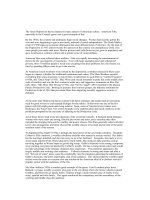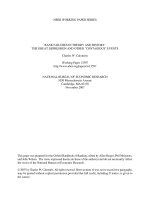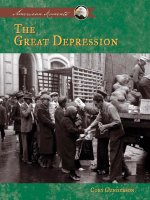5 10 the great depression
Bạn đang xem bản rút gọn của tài liệu. Xem và tải ngay bản đầy đủ của tài liệu tại đây (5.48 MB, 10 trang )
THE GREAT
DEPRESSION
Fascinating Facts
• After Roosevelt’s election, Charles Edison, president of
Thomas A. Edison, Inc., posted this notice: “President
Roosevelt has done his part; now you do something. . . . It
doesn’t matter what you do—but get going and keep going.
This old world is starting to move.”
• During his first one hundred days in office, Roosevelt
introduced fifteen major laws, gave fifteen messages
to Congress, and held press conferences and cabinet
meetings twice a week.
• More than 2 million young men worked in the Civilian
Conservation Corps. More than 100,000 of the men
learned to read and write.
Genre
Nonfiction
Comprehension Skill
Summarize
Text Features
• Primary Source
• Captions
• Glossary
Scott Foresman Social Studies
ISBN 0-328-14907-1
ì<(sk$m)=bejaha< +^-Ä-U-Ä-U
by Scott Gillam
In 1929 the economy of the United States suffered
great losses when stock prices fell. The next twelve
years became known as the Great Depression. In this
book you will read about how the Great Depression
affected people and how the nation faced the
challenges of these hard times.
THE GREAT
DEPRESSION
Write to It!
Franklin Roosevelt gave speeches to Congress as well
as radio talks to the nation. Write a speech that he
might have given to introduce his New Deal programs
and to explain how they would help the economy.
Write your speech on a separate sheet of paper.
Vocabulary
unemployment
depression
stock market
crash
migrant worker
Photographs
by Scott Gillam
Every effort has been made to secure permission and provide appropriate credit for photographic material. The publisher deeply
regrets any omission and pledges to correct errors called to its attention in subsequent editions.
Unless otherwise acknowledged, all photographs are the property of Scott Foresman, a division of Pearson Education.
Photo locators denoted as follows: Top (T), Center (C), Bottom (B), Left (L), Right (R) Background (Bkgd)
ISBN: 0-328-14907-1
Copyright © Pearson Education, Inc.
All Rights Reserved. Printed in the United States of America. This publication is protected
by Copyright, and permission should be obtained from the publisher prior to any prohibited
reproduction, storage in a retrieval system, or transmission in any form by any means,
electronic, mechanical, photocopying, recording, or likewise. For information regarding
permission(s), write to: Permissions Department, Scott Foresman, 1900 East Lake Avenue,
Glenview, Illinois 60025.
1 2 3 4 5 6 7 8 9 10 V0G1 14 13 12 11 10 09 08 07 06 05
Opener: ©Getty Images
Editorial Offices: Glenview, Illinois • Parsippany, New Jersey • New York, New York
3 ©Bettmann/Corbis
4 ©Corbis
Sales Offices: Needham, Massachusetts • Duluth, Georgia • Glenview, Illinois
5 ©Library of Congress/Bridgeman Art Library
Coppell, Texas • Sacramento, California • Mesa, Arizona
7 ©Corbis
8 ©Corbis
10 ©Bettmann/ Corbis
12 ©Corbis
13 ©Corbis
14 ©Underwood & Underwood/Corbis
Hard Times in the United States
From late 1929 until 1933, the economy of the United
States declined steeply. Unemployment, or the number
of those without jobs, rose from 3 percent to almost 25
percent of the labor force. Money invested in business fell
to almost nothing. The number of new houses being built
fell by 80 percent. The value of all goods produced in the
nation dropped by 29 percent. Farm families, who made
up 25 percent of the population in 1934, were especially
hit hard. Lack of rain, poor farming practices, and low food
prices forced many farmers off their land. Many farms in
the Midwest and parts of the South had to be sold between
1930 and 1935. Hundreds of thousands of farmers and
their families moved west to California and what they hoped
would be a better life. The Great Depression had arrived. A
depression is a period of severe decline in an economy. The
Great Depression would last for the rest of the 1930s. Only
with the beginning of World War II would the economy begin
to improve.
The Stock Market Crash
Many people lost their savings in the stock market crash of 1929.
The crash also hurt small investors who had borrowed money to invest.
On October 29, 1929, prices on the stock market did
not just fall—they declined steeply. Over the first six days,
25 billion dollars’ worth of stocks was lost in the crash of
the stock market. A crash is a sudden and severe decline in
business. Even well-known stocks fell like stones. Fortunes
were lost overnight. People who had been wealthy—at least
by the value of their stocks—were forced to sell their houses
and cars to survive. Some people even sold apples on the
sidewalk for a nickel each to provide food for their families.
Although many people were not affected by the economy’s
sudden decline, some people were. Jane Yoder, one of seven
children of a miner who had lost his job, remembers, “We
were struggling, just desperate to be warm. No blankets, no
coats.” Ed Paulsen heard about an opening for a construction
job. He showed up to apply for the job only to find thousands
of people ahead of him. “More and more men were after
fewer and fewer jobs,” Paulsen said.
2
3
The Great Depression
The 1920s saw the arrival of many new consumer
goods on the market.
The 1920s
Interestingly, many people were doing well financially during
the 1920s. World War I had created a great need for more
food and other goods. Farmers had been encouraged to grow
more crops. The average wage was up, and inventions such
as the automobile, radio, and motion pictures, or movies,
had encouraged people to buy more goods. The companies
that made these goods made a profit. The biggest problem
was stock price inflation. Inflation occurred when people were
encouraged to buy stock, or shares of ownership, in these
companies, which then increased the price of the shares.
People often borrowed money from banks to buy shares. If
the price of these shares went down, buyers would not only
lose what they had paid but also owe the money they had
borrowed. If they could not repay the money, buyers would go
broke, and the banks themselves might fail, or go broke.
4
People without jobs had less money to spend. When banks
failed, even people with money lost confidence in the economy
and began to spend less. The national income from 1929 to
1932 fell from more than $80 billion to less than $50 billion.
Those without jobs turned to relatives and private charity for
help. There was no federal system of welfare, or aid to those
who could not support themselves. People who had lost
their homes usually moved, looking for shelter anywhere they
could find it. In Pittsburgh in late 1931, nearly fifteen hundred
people were sleeping outdoors on train platforms, loading
docks, or in doorways, or they built houses out of anything
available. Groups of these types of houses came to be known
as “Hoovervilles.” They were named after Herbert Hoover, the
President of the United States from 1929, when the Great
Depression began, until 1932.
Those without jobs and money had to wait in long lines
to be fed by private charities.
5
The Dust Bowl
The boom years for farming that occurred during
World War I were soon over when Europe began
growing its own crops again. Prices dropped and
American farms went into a depression during the
early 1920s. Farmers had borrowed money during
the war to buy land and machinery at inflated
prices. Now these farmers were stuck paying the
bills for these purchases with the lower profits
from much smaller crops. Small farms were also
the victims of new machinery. As new tractors and
harvesters replaced farm workers, only large farms
that could afford these expensive machines were
able to survive. There were no longer self-sufficient
farmers who produced enough to feed their families
with a little left over. Unemployed farm workers joined
other unemployed people on the road as migrant
workers, and headed to California, where they hoped
they would find jobs.
Encouraged by the ability of the new tractors to plow
more land than horse-drawn equipment, farmers took
advantage of rising prices during World War I to produce
so much food that they wore out the land. Much of the
land that was once used for grazing cattle was now used
for growing wheat. However, root systems that held the soil
in place were destroyed. Drought made the conditions worse,
and soon much of the soil was gone, blown away as dust.
Farm families were not the only ones to feel the economic
pinch, even before the Depression. In 1929, 75 percent of
all families made less than $3,000 a year, including 6 million
who made less than $1,000 a year.
Many farmers who lost their land during the Depression
traveled west to California in search of jobs.
7
6
7
Franklin Delano Roosevelt’s
New Deal
Franklin Delano Roosevelt became President in 1933.
8
Franklin Delano Roosevelt defeated Herbert Hoover
and became President in 1933. Even though polio had
left Roosevelt unable to walk without crutches, he led an
active fight against the economic despair that gripped the
country. Herbert Hoover had appealed to businesses and
private charities to fight the Depression. Roosevelt, however,
believed that government had an important role to play. His
program, called the New Deal, created dozens of projects
designed to improve the economy by providing jobs. Many
of these programs were started during the first one hundred
days of Roosevelt’s first term of office. The programs were
divided into three general groups: relief, recovery, and reform.
Relief programs focused on providing immediate action
to halt the decline of the economy. Recovery programs were
designed to renew consumer demand by putting money
directly into their hands. Reform programs were meant
to lessen the impact of any future economic disasters.
Many of these New Deal programs were so successful
that they still exist today. For example, the Securities
and Exchange Commission, Federal Deposit Insurance
Corporation, Tennessee Valley Authority, and Social Security
Administration are still key parts of the federal government.
The Securities and Exchange Commission is a government
agency that supervises the stock market. The Federal
Deposit Insurance Corporation (FDIC) insures savings bank
deposits. The Tennessee Valley Authority is the largest
public provider of power in the nation. The Social Security
Administration provides monthly payments to senior citizens.
9
Roosevelt Fights the Depression
At the end of his first term, Roosevelt was very popular.
Confidence in the banks was back. More people had jobs,
and large government construction jobs were expanding. The
nation’s total economic activity, which had been declining
since 1930, increased between 1934 and 1937. Roosevelt
won reelection in 1936 in a landslide, or a great majority
of votes. The president worked with his determined wife,
Eleanor, who visited hospitals, schools, and other New Deal
projects across the country. Roosevelt helped build public
support for his cause through regular informal
talks, called “fireside chats,” on the radio to
explain his programs and his plans for the
future. Together, Roosevelt and his wife gave
hope to many who had been in despair.
Despite these improvements, however, the economy as
a whole was still depressed. The percentage of workers
without jobs rose almost 5 percent in 1938, when almost
one in five workers were unemployed. Roosevelt’s proposal
to expand the Supreme Court was widely criticized.
Meanwhile, the Supreme Court declared the sit-down strike,
in which workers “sat down” on the job to strike for better
wages, against the law. Only the increased spending caused
by the beginning of World War II finally brought the nation out
of the depression that had gripped it for twelve years.
Roosevelt was the first President to
effectively use the medium of radio,
which was in many homes during the
1930s, to reach the public.
10
11
Entertainment in the 1930s
While television may be the main form of entertainment
today, movies were far more popular in the 1930s. Movies
were not only a way to escape one’s problems, but they were
also a way to accept them. More than 60 percent of the
entire American population went to the movies each week
during the Depression—six times as many as during the
1970s. In the 1933 movie 42nd Street, a chorus girl learns
the leading role for a musical in only five hours, after the star
breaks her leg, and goes on to become a huge success. The
unlikely victory of the racehorse Seabiscuit over War Admiral
in a famous horse race in 1938 also became a symbol of
the Depression.
The history of the Depression can be traced
in the period’s movies.
The unemployment rate rose almost 5 percent in 1938, even as
the nation began to prepare for war.
The Depression Ends
Until 1937 Roosevelt was concerned mostly with fighting the
Depression’s effects at home. After Japan’s invasion of China
that year, however, Roosevelt warned the Axis powers that any
further attacks would be resisted. Roosevelt won congressional
approval in 1939 for more than $300 million in new warships.
After Germany invaded Poland in 1939, weapons orders poured
in from England and France. It was not until 1940, however,
after Germany defeated France, that Congress passed the draft
law and took steps to help England and block Japan.
As the nation prepared for war, the number of those without
jobs fell from eight million in 1939 to four million in 1940. With
the nation threatened by a new enemy—this one abroad rather
than at home—the people elected Roosevelt to a surprising
third term. He would lead the successful fight against this new
enemy and win a fourth term in 1944, before his death in the
following year.
12
13
The Impact of the Depression
Many people disagree about how successful the New
Deal was in fighting the Depression. Few people, however,
would argue that life today is different because of its
continuing programs. These programs include Social Security,
unemployment insurance, public housing, and the minimum
wage law.
Under Roosevelt’s administration, the federal government
expanded in both size and power. Roosevelt used
government spending as a way to get the economy back
on track. While some people do not think the government
should have a large role in the nation’s economy, other
people believe that spending by the government is the best
way to solve almost any big economic problem.
The Wilson Dam in
northwest Alabama, created
by the Tennessee Valley
Authority, helps bring
electricity to many homes.
14
15
In 1929 the economy of the United States suffered
Glossary
Write to It!
great
stock prices
The next twelve
crash
a losses
suddenwhen
and severe
declinefell.
in business
years became known as the Great Depression. In this
depression
period
severe
in anDepression
economy
book you awill
read of
about
howdecline
the Great
affected
people
and how
thetravels
nationfrom
faced
theplace
migrant
worker
a worker
who
one
challenges
of search
these hard
times.
to another in
of work
Franklin Roosevelt gave speeches to Congress as well
as radio talks to the nation. Write a speech that he
might have given to introduce his New Deal programs
and to explain how they would help the economy.
stock market an organized market where stocks are
bought and sold
Write your speech on a separate sheet of paper.
Vocabulary
unemployment the number
of workers who are
unemployment
without jobs
depression
stock market
crash
migrant worker
Photographs
Every effort has been made to secure permission and provide appropriate credit for photographic material. The publisher deeply
regrets any omission and pledges to correct errors called to its attention in subsequent editions.
Unless otherwise acknowledged, all photographs are the property of Scott Foresman, a division of Pearson Education.
Photo locators denoted as follows: Top (T), Center (C), Bottom (B), Left (L), Right (R) Background (Bkgd)
ISBN: 0-328-14907-1
Copyright © Pearson Education, Inc.
All Rights Reserved. Printed in the United States of America. This publication is protected
by Copyright, and permission should be obtained from the publisher prior to any prohibited
reproduction, storage in a retrieval system, or transmission in any form by any means,
electronic, mechanical, photocopying, recording, or likewise. For information regarding
permission(s), write to: Permissions Department, Scott Foresman, 1900 East Lake Avenue,
Glenview, Illinois 60025.
1 2 3 4 5 6 7 8 9 10 V0G1 14 13 12 11 10 09 08 07 06 0516
Opener: ©Getty Images
3 ©Bettmann/Corbis
4 ©Corbis
5 ©Library of Congress/Bridgeman Art Library
7 ©Corbis
8 ©Corbis
10 ©Bettmann/ Corbis
12 ©Corbis
13 ©Corbis
14 ©Underwood & Underwood/Corbis









